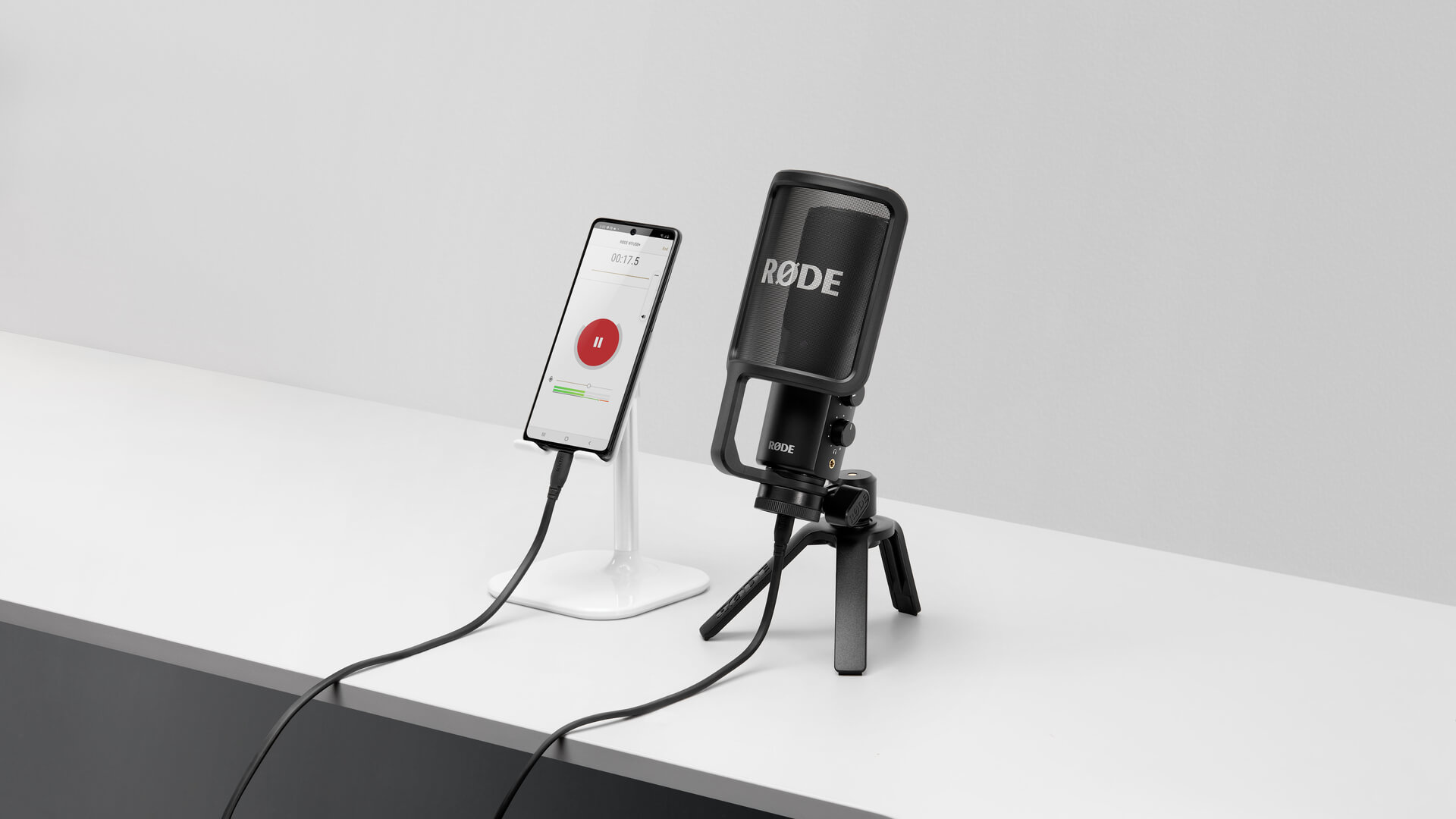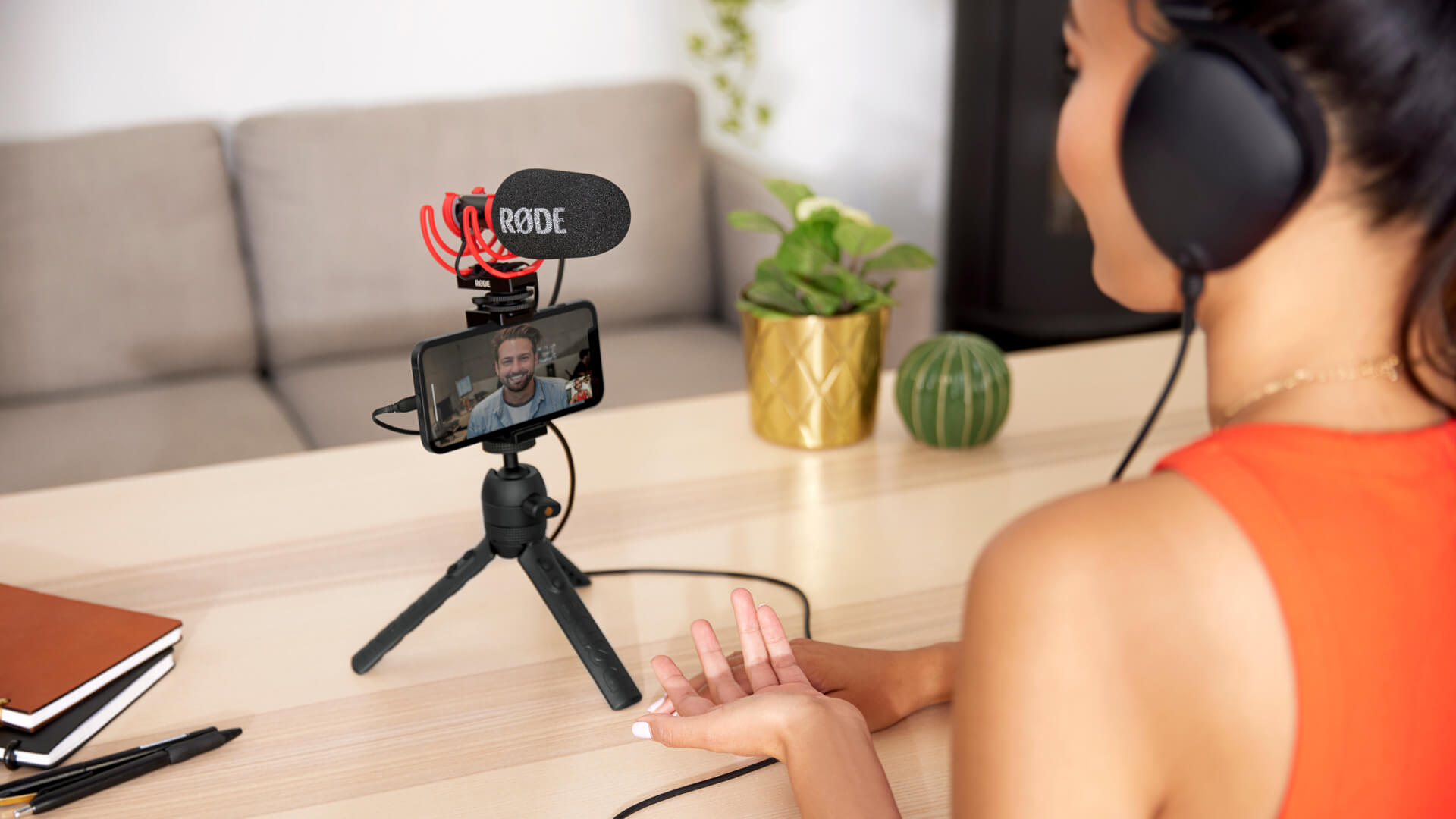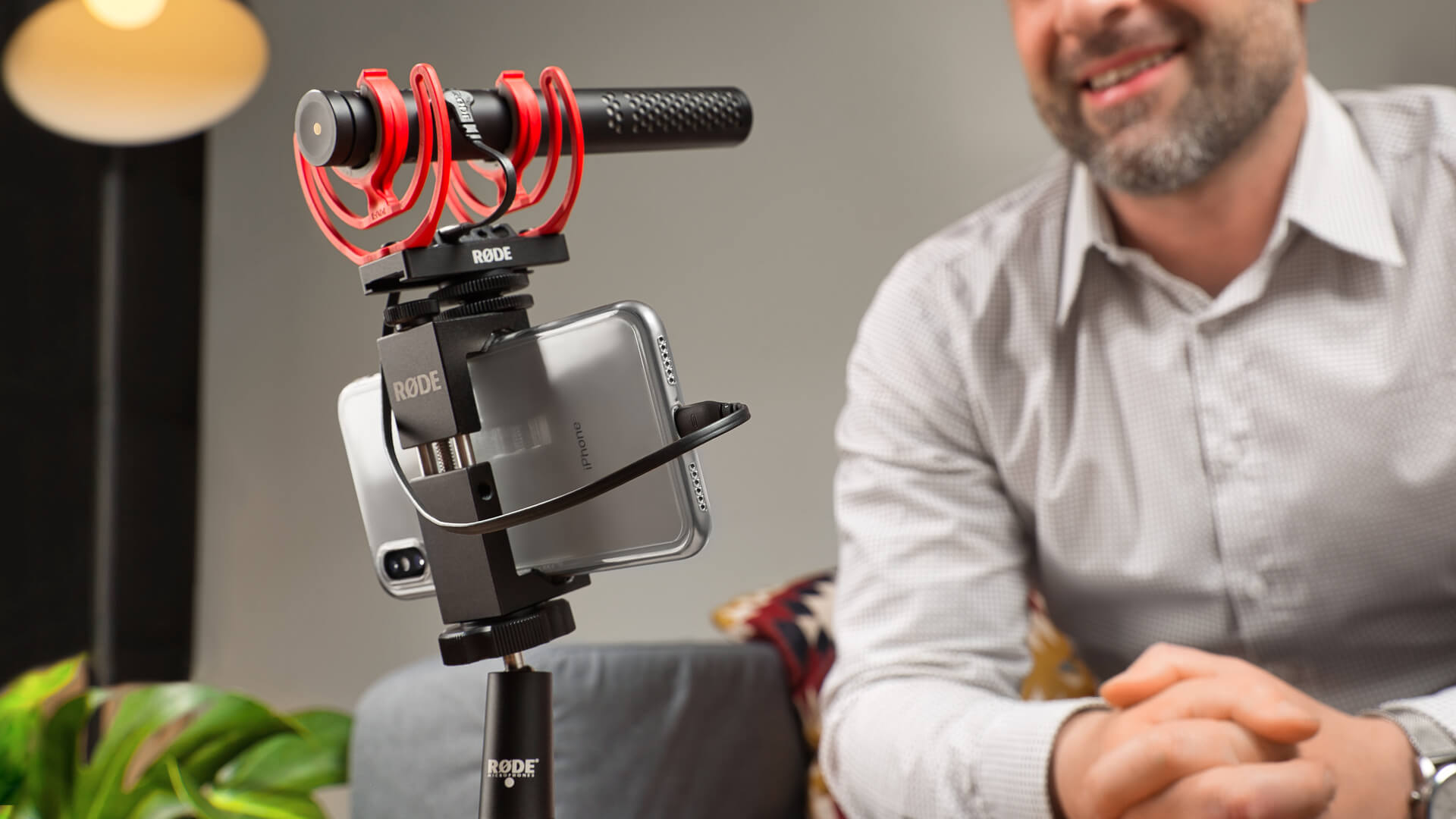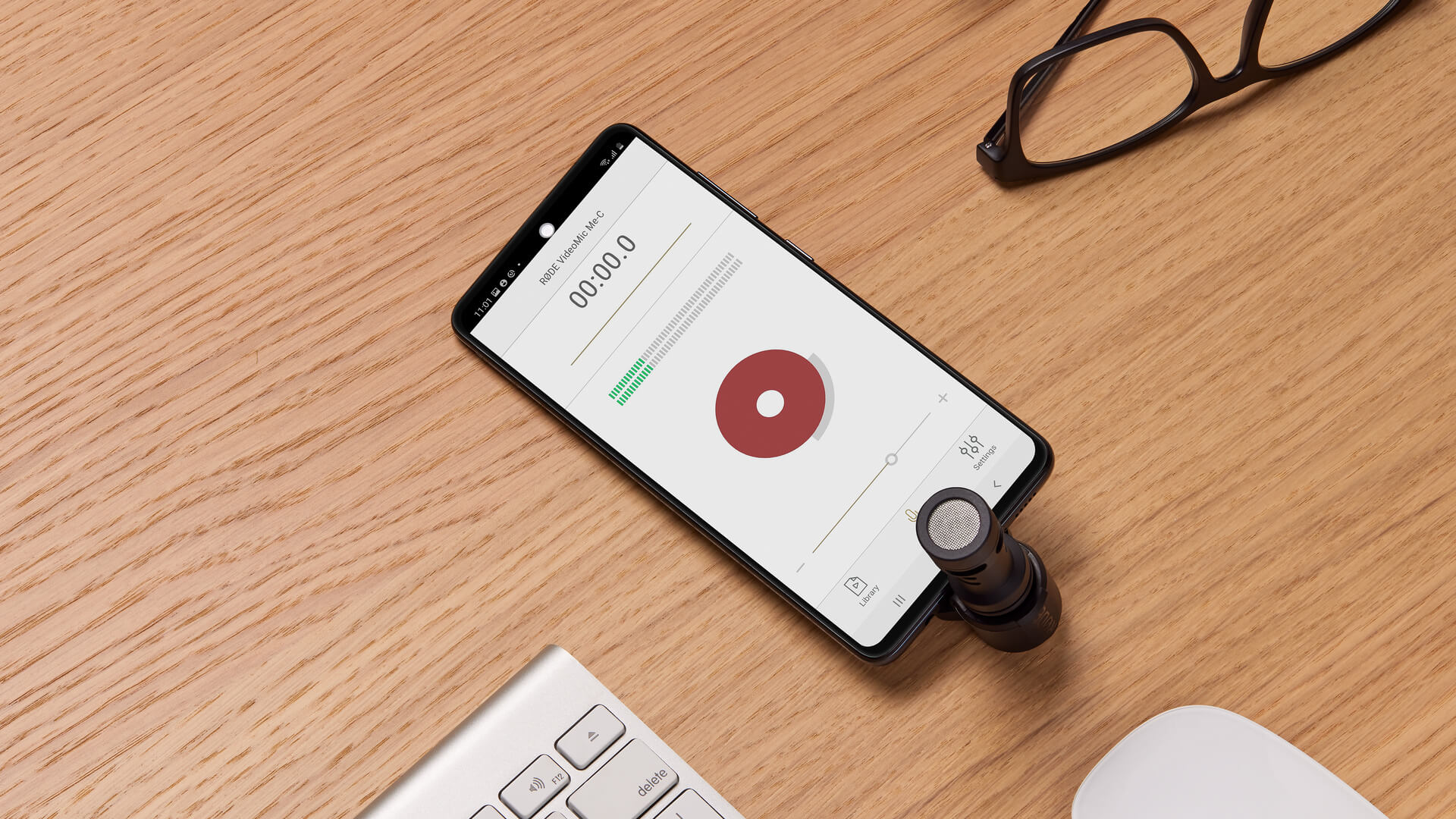Using a USB Microphone With Your iPad, iPhone or Other Mobile Device
If you're seeking a portable podcast recording solution, a video call setup on the go, a pocket-sized music studio or even a super-compact filmmaking rig, then pairing a USB microphone with a smartphone or tablet is an incredibly versatile and powerful option.
In this article, we’ll take a look at why you’d want to use a USB microphone with your mobile device, how to choose the right USB mic and how to connect it to your iPhone, iPad or Android mobile device.

The NT-USB+ professional USB microphone makes for a powerful and portable recording setup when paired with a smartphone.
Why to Use a USB Mic with your Smartphone or Tablet
Broadly speaking, any situation in which you’d normally use your phone or tablet’s on-board microphone can be drastically improved by using a USB microphone, as built-in mics in mobile devices are typically low quality.
Podcasts in your Pocket
A professional quality USB mic like the NT-USB+ is an excellent way of capturing broadcast-grade voice on your mobile device for podcasting away from home or the studio. Most noticeably, a USB mic will make your voice sound significantly more full, rich and detailed than when using your phone or tablet’s microphone, and it will better isolate your voice, boosting its clarity and reducing unwanted background noise.
Enhanced Video Calls
Pairing your phone or tablet with a USB shotgun microphone like the VideoMic GO II is the best way to get crisp, clean audio on your video calls. Shotgun mics are highly directional, meaning they’re even better than other types of microphones at isolating your voice and rejecting background noise from the sides and rear of the mic.

Shotgun microphones like the VideoMic GO II are great for picking up your voice clearly on video calls as their supercardioid pickup pattern offers superior rejection of unwanted noise from the sides and rear.
Compact Filmmaking and Content Creating Rig
With most modern smartphones having powerful video abilities, simply adding a professional USB shotgun microphone like the VideoMic NTG can turn your phone into a professional-quality videography setup that you can take with you wherever you go. You can also check out the RØDE’s Vlogger Kits (available in iOS, USB-C and Universal 3.5mm versions) for an all-in-one vlogging setup, including a high-quality compact microphone, Tripod 2, phone grip, MicroLED on-camera light and other accessories.
Portable Music Studio
With the vast array of music-making apps available for phones and tablets today, pairing your device with a high-quality USB mic like the NT-USB+ turns it into a super versatile and powerful music recording and editing suite. Tablets are generally better suited here, as you have more screen real estate (and generally more power) for handling your multitrack recordings and using processing and effects.
Choosing a USB Microphone
Any USB microphone is going to offer a massive step up in audio fidelity over the in-built microphone on your phone or tablet, but while you’re upgrading, you may as well choose a top-quality USB mic, ideally with a few specific features to help you out. Let’s take a look.
Zero-Latency Headphone Monitoring
With a few exceptions, many modern phones and tablets no longer sport a 3.5mm output, so it’s important to look out for a USB microphone with its own headphone output – thankfully this is a fairly standard feature. Better still, if you go for a USB mic with zero-latency monitoring (like our NT-USB Mini and NT-USB+), you can listen to your voice or instrument without any lag.
Without this feature, your microphone signal will be sent into your mobile device, through your audio or video app, and then back out, creating a delay that’s not only irritating when recording, but can also mess with speech patterns and music performances.

The NT-USB Mini studio-quality USB microphone features a headphone output with zero-latency monitoring.
USB Connection
There are a few different standards of connection available in USB mics, but we’d recommend you opt for a USB-C microphone. This is the latest standard and will give you the greatest flexibility when connecting your mic to a mobile device, often allowing for a single cable.
Note: Some USB mics may require more power than your phone or tablet can provide, in which case you’ll see a relevant error message display on your device when hooking up your mic. If this is the case, you may be able to provide your microphone power using something like Apple’s Lighting to USB 3 Camera Adapter (if you’re using an iPhone or iPad) and providing extra power via the second USB port on the adapter.
Connecting Your USB Microphone to an iOS Phone or Tablet
Assuming your microphone has a USB-C output, the simplest way to connect your iPhone or iPad to the USB mic is via a Lightning Accessory Cable like the SC15 or SC19. These cables directly bridge USB-C and Lightning ports and are all that’s needed to set up your USB mic with your iPhone or iPad, granted your device can provide enough power (see above note).
Some Apple products feature a USB-C port, namely the iPad Pro and later models of the iPad Air (4th-gen and later) and iPad Mini (6th-gen and later). For these, you can simply use a USB-C-to-C cable like the SC16 or SC17 to connect to your USB mic.

The VideoMic NTG not only features a USB output, but also has a number of on-board controls for processing and improving your audio, such as a high-pass filter and high-frequency boost.
If you’re using a USB microphone with a different port, you’ll need to use an adapter like Apple’s Lighting to USB Camera Adapter, which provides a USB Type-A port to plug in the cable that came with your USB mic.
Once connected, your iPhone or iPad should automatically recognise your USB mic and set it as the input and output device, but you may need to check input settings in the media app you’re working with. If you’re using a mic with a headphone volume control like the NT-USB+, you can turn up your phone or tablet’s volume to maximum and use your microphone’s volume control to adjust levels to taste.
Connecting Your USB Microphone to an Android Phone or Tablet
Most modern Android phones and tablets now feature a USB-C port, which means you can use a USB-C to USB-C cable like the SC16 or SC17 to directly connect it to your microphone, assuming your device can provide enough power to your mic.
Once connected, your Android device should automatically set your USB mic as the input and output device, and you can use your audio, video and conference apps as normal – if not, check the audio settings in your app. As with iOS devices, you may need to use an adapter if your microphone and/or mobile device doesn’t have a USB-C port or if your device can’t provide enough power for your mic.
Android and iOS Recording Apps
Once your USB mic is hooked up to your phone or tablet, there’s a massive range of both iOS and Android apps you can make use of, including filmmaking apps, video and conference call apps like Zoom and even fully-featured music production workstations.

Pairing a VideoMic Me-C or VideoMic Me-L with a smartphone running RØDE Reporter is a super simple and compact solution to recording pro audio.
For a simple yet capable option for recording audio, check out the RØDE Reporter app. It features a microphone input level control, audio meter, media library and the option to record your audio as a hi-res WAV file for the highest quality or a compressed MP3 file with a number of different quality options to save on storage space.
Pro Tip: Switch your phone or tablet into flight mode (unless your recording situation needs it) in order to avoid any unwanted interruptions during recording, as well as possible interference from the cellular or wireless signals.
RØDE offers a range of professional USB microphones to suit a wide range of uses, as well as a number of on-camera VideoMics that feature both 3.5mm and USB-C connections.